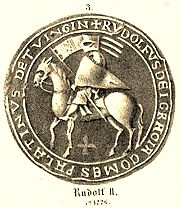Rudolf II (Tübingen)
Rudolf II († November 1, 1247 ) was Count Palatine of Tübingen and Vogt of Sindelfingen.
family
He was the younger son of Count Palatine Rudolf I of Tübingen and Mechthild von Gießen , heir daughter of Count Wilhelm von Gleiberg . He was married to a daughter of Margrave Heinrich from the von Ronsberg family and Udilhild von Gammertingen. The two had the following children:
- Hugo IV. Count Palatine of Tübingen
- Rudolf I the Scheerer , Count of Tübingen in Herrenberg († May 12, 1277)
- Ulrich
- Mechthild ∞ Burkhard V. Count von Hohenberg († July 14, 1253 struck by lightning); their daughter Gertrud Anna (* around 1225; † February 16, 1281) was the wife of Rudolf I of Habsburg .
Live and act
After the death of his brother Hugo, Rudolf II represented the palace of the Palatinate. From 1224 he appears in many imperial documents as Count Palatine, while his brother Wilhelm next to him only writes Count. Rudolf II. Was benevolent to the Bebenhausen Monastery , which his parents had donated , as can be seen from several documents. In addition to his father, Rudolf II is the Count Palatine of Tübingen who appears most frequently in imperial documents, namely in documents of Henry VII , son of Frederick II , who was elected King of Rome at the age of 8 (1220) , who lived mainly in Italy stayed while his son stayed in his native Swabia, and later, after falling out with his father in 1232, did everything possible to win over the Swabian greats. Rudolf II also seems to have belonged to these, at least he, who is mentioned in 10 documents of the son, does not appear in any of the father's documents, and even then with the son when the latter openly spoke up against his father. Given the energetic character of Rudolf II, it can be assumed that, like others, he would have used the emperor's many years of absence and the son's efforts to win the Swabian greats to his side to expand his power and to establish as free a position as possible .
Count Palatine Rudolf II and his brother Wilhelm were with Heinrich VII in Worms on January 8, 1224 , with other greats, Count Hartmann von Wirtemberg and a Count of Dillingen, on April 5, 1227 in Oppenheim and on May 1 in Hagenau together with Hermann Margraves of Baden, Eberhard, Truchsessen von Waldburg, who made great contributions to Swabia as guardian and advisor to Heinrich VII. In the same year he met Ludwig, the Duke of Bavaria and German imperial administrator and the tavern Konrad von Winterstetten, who was also on the council of the young prince. On February 23, 1228 he was in Ulm with the Lords of Neuffen and the Reichsmarschall Anselm von Justingen. On August 31, 1228 he appeared with the Margrave of Baden, Heinrich, Count of Wirtemberg, a Count of Dillingen, the above-mentioned councilors, Konrad von Weinsperg as a witness in a document with which Heinrich VII. The privileges of the Adelber monastery in Eßlingen confirmed, and in the same year and in the same place in 4 documents of the Duke Ludwig of Bavaria and Bishop Ekberts of Bamberg, among others next to Hermann, Margraves of Baden, Ulrich and Eberhard, Counts of Helfenstein, Eberhard and Otto, Counts of Eberstein, Gottfried von Hohenlohe and the two councilors.
On April 29, 1231 he was at the brilliant Reichstag of Emperor Frederick II of Worms with many bishops, dukes and counts, including Albrecht von Habsburg , Friedrich von Zollern , a Count of Eberstein. Rudolf was at the head of 8 counts in the ranking. On November 22nd, 1231 he and his brother Wilhelm were with Count Albert von Rottenburg (Hohenberg), Ulrich von Helfenstein and Eberhard von Walpurg with Heinrich in Ulm. Together with his brother Wilhelm, he sealed a certificate with Konrad, Duke von Teck, Hermann Margrave of Baden and others on December 31, which Heinrich had issued to the Neresheim monastery in Wimpfen . For the last time he appeared with King Heinrich VII on June 4, 1233 in Esslingen next to his brother Wilhelm.
When Pope Gregory IX. In 1235, when the princes of the empire called on an armed procession to the Holy Land to assist the beleaguered church, Rudolf II was also warned, and he is the only great Swabian named in the warning letter. It is not known whether he obeyed the Pope's request. The fact that he is not mentioned between 1235 and 1243 could make the assumption of a longer absence likely. It is also striking that the history books contain no information about the position Palatine Count Rudolf II assumed in the battle between King Konrad and the opposing king Heinrich Raspe , all the more so as Swabia was partly the scene of the same. The document that the papal legate issued in favor of the Bebenhausen monastery at Rudolf's request in the camp in front of Ulm on January 28, 1247, should mean that he was on the side of the opposing king.
Remarks
- ↑ a b c d Ludwig Schmid: History of the Count Palatine of Tübingen, according to mostly unprinted sources, together with the document book. A contribution to Swabian and German history. Fues, Tübingen 1853, pp. 135-150 .
| personal data | |
|---|---|
| SURNAME | Rudolf II. |
| BRIEF DESCRIPTION | Count Palatine of Tübingen |
| DATE OF BIRTH | 12th century or 13th century |
| DATE OF DEATH | November 1, 1247 |
